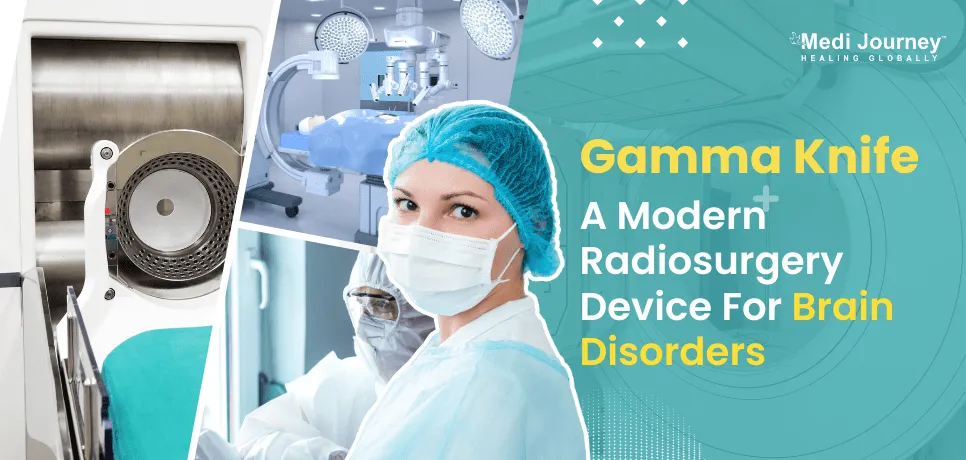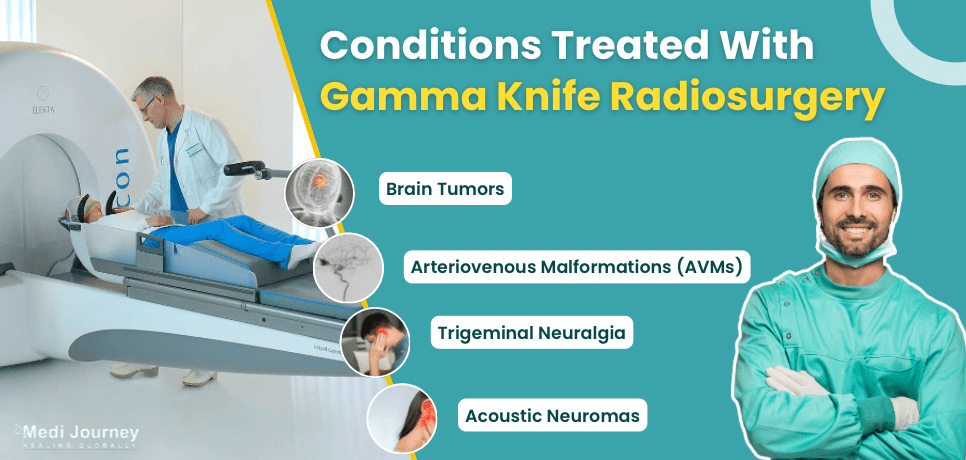Best Orthopedic Surgeons in Artemis Hospital Gurgaon
 17 December,2025
Read More
17 December,2025
Read More
Enquire now in case of any assistance needed
 24 December,2024
24 December,2024

Gamma Knife radiosurgery was first introduced in the 1980s in the US and the UK. It is a cutting-edge, noninvasive treatment option for various brain conditions. Known for its precision and effectiveness, it offers a promising alternative to traditional surgical methods. This blog will cover everything you need to know about Gamma knife radiosurgery, from its purpose and process to preparation, risks, and recovery.
Fill up the form and get assured assitance within 24 hrs!
GammaKnife radiosurgery isn't surgery in the conventional sense. Instead, it is a form of stereotactic radiosurgery (SRS) that uses targeted beams of gamma radiation to treat abnormalities in the brain. Despite the name, no scalpel or incision is involved.
This treatment uses a sophisticated device to focus nearly 200 radiation beams on a specific brain area. Each beam individually is low-powered and harmless to the surrounding tissue. However, when these beams converge at the target point, they deliver a high dose of radiation to destroy abnormal tissue while sparing nearby healthy tissue. It is often used to treat brain tumors, vascular malformations, trigeminal neuralgia, and other conditions.
Gamma Knife surgery is especially valuable for treating conditions in delicate or hard-to-reach areas of the brain where traditional surgery poses higher risks. Its precision reduces the likelihood of complications and ensures faster recovery times, making it a preferred option for many patients and doctors alike.
Over the years, Gamma Knife technology has evolved significantly. Here are the main types of systems currently in use:

Gamma Knife Radiosurgery is performed for a variety of reasons. It offers a less invasive alternative for conditions that may otherwise require open-brain surgery. Here are some common applications:
Preparation for Gamma Knife Radiosurgery involves several steps to ensure accuracy and safety.
Here's what typically happens during the procedure:

While Gamma Knife is generally safe, like any medical procedure, it carries potential risks:
Gamma Knife radiosurgery offers several benefits over traditional open surgeries. These include:
Gamma Knife Radiosurgery is a revolutionary treatment offering precision, safety, and effectiveness for various brain conditions. By minimizing risks and avoiding invasive surgery, it provides hope and improved outcomes for patients worldwide. If you're considering this procedure, consult your doctor to determine if it's the right choice for you.
Fill up the form and get assured assitance within 24 hrs!
Doctor of Pharmacy
Dr. Deepanshu Siwach is a skilled clinical pharmacist with a Doctor of Pharmacy degree.?He has 4+?years of experience and has worked with thousands of patients. He has been associated with some of the top hospitals, such as Artemis Gurgaon.
Dr. Kaustav Talapatra is a renowned Radiation oncologist in Mumbai. With over 25 years of extensive experience, he has reated over 7,000 patients with radiation therapy. Dr. Kaustav is skilled in cranial radiation therapy, extracranial radiosurgery, and stereotactic body radiotherapy....
No, the procedure is painless. You won't feel the radiation, and any discomfort from the head frame or mask is temporary.
The procedure can last from 30 minutes to a couple of hours, depending on the complexity of the treatment area.
Yes, in some cases, repeated Gamma Knife treatments are possible if needed.
Yes, it is a highly precise and safe procedure with minimal risks compared to traditional surgery.
Gamma Knife surgery is highly effective, offering relief or halting disease progression. The success rate of various diseases treated with Gamma Knife surgery is as follows:
Gamma Knife is a daycare procedure that allows patients to go home on the same day. Most resume normal activities within a day.
Follow-up imaging (MRI or CT scans) and symptom improvement help determine the success of the treatment. Below are the timelines for the effects of Gamma Knife treatment on different medical conditions.
Senior Consultant
Medical Oncologist
Nanavati Super Specialty Hospital, Mumbai
WhatsApp UsSenior Director
Gynecologist and Obstetrician, IVF Specialist
Max Super Speciality Hospital, Shalimar Bagh, New Delhi
WhatsApp UsSenior Director
Gynecologist and Obstetrician, IVF Specialist
Max Smart Super Speciality Hospital, Saket, New Delhi
WhatsApp UsSenior Director
Gynecologist and Obstetrician
Max Smart Super Speciality Hospital, Saket, New Delhi
WhatsApp UsSenior Director
Gynecologist and Obstetrician
Max Smart Super Speciality Hospital, Saket, New Delhi
WhatsApp UsSenior Director
Gynecologist and Obstetrician
Max Smart Super Speciality Hospital, Saket, New Delhi
WhatsApp UsThe Art of Effective Communication
 17 December,2025
Read More
17 December,2025
Read More
 16 December,2025
Read More
16 December,2025
Read More
 10 December,2025
Read More
10 December,2025
Read More
 09 December,2025
Read More
09 December,2025
Read More
 05 December,2025
Read More
05 December,2025
Read More
 04 December,2025
Read More
04 December,2025
Read More
Trusted by Patients
"I am Asim from Bangladesh and was looking for treatment in India for neuro. I visited many websites to get the complete information regarding the treatment but I was not satisfied as I was getting confused. In the meanwhile, one of my friends suggested I seek help from Medi Journey as he experienced his medical journey very smoothly and was satisfied with it. They have filtered the top 10 doctors as per experience, the success rate of surgery & profile, so it helps us to choose the best treatment in India. "
"For my knee surgery, Medi Journey guided me to BLK Hospital where I received exceptional care. The team's support and the expertise at BLK Hospital exceeded my expectations. Thank you Medi Journey for making my medical journey stress-free. "
"I came from Iraq for my granddaughter's eye surgery in India facilitated by Medi Journey, due to critical cases they advised us to get a second opinion from the different hospitals before going to surgery. Finally, we went to Fortis Escort Hospital, which helped us to get more confidence for diagnosis. Fortis Escort Hospital has the best eye surgeon team with the latest instruments. Thanks to all team members for providing a high-quality treatment in India at an affordable cost. "
"I came for my hair transplant in India, before coming I was so confused about choosing the best clinic and surgeon for me. But thanks to God one of my friends had a hair transplant in India through Medi Journey. He recommended me to go with them. I am completely happy with my experience with them. They were always very fast in their responses to me. the success rate of my hair transplant surgery is 100%."
"Artemis Hospital, suggested by Medi Journey, turned out to be a great choice for my treatment. The personalized assistance and medical care were exceptional. I'm grateful to Medi Journey for guiding me to a hospital that perfectly matched my needs. Highly recommended! "
"I came from Afghanistan for my treatment in India at Jaypee Hospital, Noida. I had a fantastic experience with Medi Journey. Kudos to them for their incredible support during my medical journey. They not only took care of all the logistics but also connected me with a fantastic healthcare team. Efficient, caring, and highly recommended for a hassle-free medical tourism experience."
"I am Adam from Kano, Nigeria, one of my friends from Nigeria was facilitated by Medi Journey, and he recommended us to go with them. I sent my all reports to them and within 48 hours they reverted with 4 options from different hospitals. They helped me to get a Visa letter from the hospital, arrange pick-up from the airport, and book a hotel for me. Their team is very honest and throughout our stay in India they are with us they are caring for us like his family members. BLK Hospital is the best hospital in India with a top surgical oncologist surgeon team, a very advanced OT, and a Radiotherapy department. I wish more success to Medi Journey. "
"Great experience at the Max Hospital for my spine surgery and was successfully done. I thank my neurosurgeon and his entire team. I recommended all of my country's people to Medi Journey for treatment in India, they choose the best hospital, the best doctors, and the best cost for patients."
"I came to India from Dhaka, Bangladesh for my father-in-law's cardiac surgery at Fortis Hospital. I was confused about choosing the best surgeon for him before coming, but their team helped me to choose the best hospital and best cardiac surgeon in India with very good cost and 100% success rate of surgery. I am very happy with the services, really they make my journey so comfortable that make me feel at home. Thanks again and I like people to choose "Medi Journey" as your travel guide. "
"I am Mohammad from Bangladesh came to India for my general health checkup. Medi Journey offers me the complete package including Pick-up from the airport, hotel services, and 24-hour assistance. They guide you to choose the best hospital in India, the best cost of treatment with top-most doctors and give you complete information about hotel booking, and pick-up from the airport before coming to India They have the best team to help. Always choose Medi Journey for your treatment in India."





